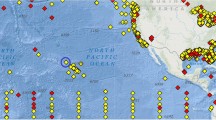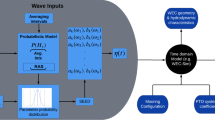Abstract
The present work explores the possibility of predicting future waves by extending the Kalman filter algorithm by incorporating the spatial distance between two points. Experimental data at 2D tank are used to validate the effectiveness of the proposed method. When causality limitation is fulfilled, it is found that 3–8 s or several cycles of waves ahead can be predicted in model scale, depending on the distance between the two points. If a scaling of 1/100 is adopted, this means 30–80 s waves ahead can be estimated. The longer the distance, the longer future predictable time will be. Response predictions using wave prediction data are also investigated. The results for the response prediction also exhibits high accuracy, with even higher predictable future time (80–120 s ahead given 1/100 scale ratio) compared to its associated predictable future time of waves.














Similar content being viewed by others
Availability of data and materials
The data that have been used are confidential.
References
Butterfield S, Musial W, Jonkman J, Sclavounos P (2005) Engineering challenges for floating offshore wind turbines. In: Copenhagen offshore wind conference, Copenhagen
Castellà XT (2020) Operation and maintenance costs for offshore wind farm: analysis and strategies to reduce O&M costs. Master thesis. Industrial Engineering, BarcelonaTech and NTUST Taiwan
Ciuriuc A, Rapha JI, Guanche R, Domínguez-García JL (2022) Digital tools for floating offshore wind turbines (FOWT): a state of the art. Energy Rep 8:1207–1228
Davis MC, Zarnick EE (1966) Testing ship models in transient waves. David Taylor Model Basin, Department of the Navy, Washington, DC
Ellabban O, Abu-Rub H, Blaabjerg F (2014) Renewable energy resources: current status, future prospects and their enabling technology. Renew Sustain Energy Rev 39:748–764
Esteban MD, Diez JJ, López JS, Negro V (2011) Why offshore wind energy? Renewable Energy 36:444–450
Esteban MD, López-Gutiérrez J-S, Negro V (2020) Offshore wind farms. J Mar Sci Eng 8:1–2
Iida T, Minoura M (2022) Analytical solution of impulse response function of finite-depth water waves. Ocean Eng 249:110862
IRENA (2019) Future of wind: deployment, investment, technology, grid integration and socio-economic aspects (A Global Energy Transformation Paper). International Renewable Energy Agency, Abu Dhabi
Isnaini R, Toichi K, Iijima K, Tatsumi A (2022a) Real-time prediction of incoming wave profile surrounding floating offshore wind turbine using kalman filter. In: Proceedings of the ASME 2022 41st OMAE, Hamburg
Isnaini R, Toichi K, Tatsumi A, Iijima K (2022b) Real-time wave prediction for floating offshore wind turbine based on the kalman filter. In: RENEW2022, Lisbon
Kalman RE (1960) A new approach to linear filtering and predictions problems. J Basic Eng 82:35–45
Kashiwagi M (2018) Wave-body interaction theory (theory of ship waves). Dept. of NAOE, Osaka University, Osaka
Komoriyama Y, Iijima K, Fujikubo M (2022) A kalman filtering technique for prediction of wave time histories around ship based on response measurements and its experimental validation. In: Proceedings of the ASME 2022 41st OMAE, Hamburg
Law YZ, Santo H, Lim K, Chan E (2020) Deterministic wave prediction for unidirectional sea-states in real-time using Artificial Neural Network. Ocean Eng. https://doi.org/10.1016/j.oceaneng.2019.106722
Pascoal R, Soares CG (2009) Kalman filtering of vessel motions for ocean wave directional spectrum estimation. Ocean Eng 36:477–488
Pascoal R, Perera P, Soares CG (2017) Estimation of directional sea spectra from ship motions in sea trials. Ocean Eng 132:126–137
Sánchez S, López-Gutiérrez J-S, Negro V, Esteban MD (2019) Foundations in offshore wind farms: evolution, characteristics and range of use. Analysis of main dimensional in monopile foundation. J Mar Sci Eng 7:441
Tillenburg D (2021) Technical challenges of floating offshore wind turbines—an overview. FH Münster - University of Applied Sciences
Wang M, Wang C, Hnydiuk-Stefan A, Feng S, Atilla I, Li Z (2021) Recent progress on reliability analysis of offshore wind turbine support structures considering digital twin solutions. Ocean Eng 232:109168
Wu X, Hub Y, Li Y, Yang J, Duan L, Wang T, Liao S (2019) Foundation of offshore wind turbines: a review. Renew Sustain Energy Rev 104:379–393
Zhang J, Zhao X, Jin S, Greaves D (2022) Phase-resolved real-time ocean wave prediction with quantified uncertainty based on variational Bayesian machine. Appl Energy. https://doi.org/10.1016/j.apenergy.2022.119711
Acknowledgements
It is acknowledged that this research has been supported by the 2022 Sasakawa research grants by the Japan Science Society (JSS) and Japan Society for the Promotion of Science (JSPS) KAKENHI grant no. 20H02367. The authors are also thankful for the assistance from the members of FOWT research group (Mr. Tsukamoto, K, Mr. Toichi, K, Mr. Yoshioka, A, and Mr. Watanabe, Y), and Xie, BY of Structural Integrity Subarea during the experiment.
Funding
It is acknowledged that this research has been supported by the 2022 Sasakawa research Grants by the Japan Science Society (JSS) and Japan Society for the Promotion of Science (JSPS) KAKENHI Grant No. 20H02367.
Author information
Authors and Affiliations
Contributions
RI wrote the main manuscript and conducted the experiment. All authors conceptualized the study and reviewed the manuscript.
Corresponding author
Ethics declarations
Conflict of interest
The authors have no competing interests to declare that are relevant to the content of this article.
Ethical approval
Not applicable.
Additional information
Publisher's Note
Springer Nature remains neutral with regard to jurisdictional claims in published maps and institutional affiliations.
Rights and permissions
Springer Nature or its licensor (e.g. a society or other partner) holds exclusive rights to this article under a publishing agreement with the author(s) or other rightsholder(s); author self-archiving of the accepted manuscript version of this article is solely governed by the terms of such publishing agreement and applicable law.
About this article
Cite this article
Isnaini, R., Tatsumi, A. & Iijima, K. Future predictions of wave and response of multiple floating bodies based on the Kalman filter algorithm. J. Ocean Eng. Mar. Energy 10, 137–154 (2024). https://doi.org/10.1007/s40722-023-00304-y
Received:
Accepted:
Published:
Issue Date:
DOI: https://doi.org/10.1007/s40722-023-00304-y




